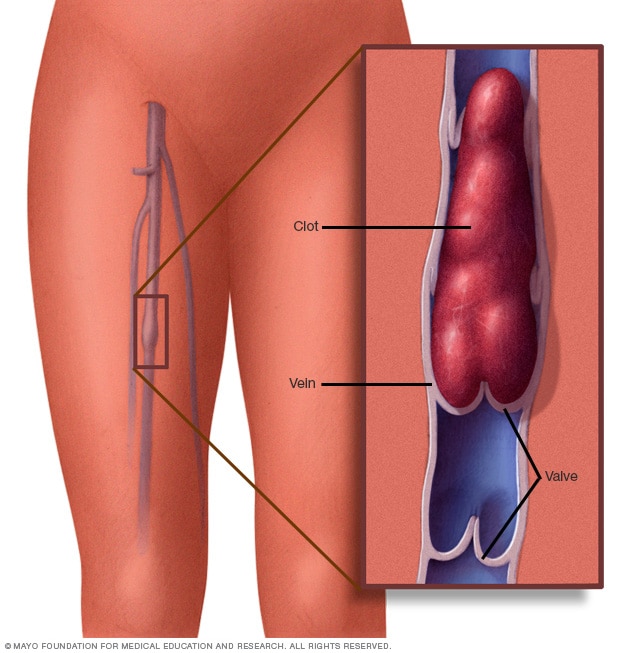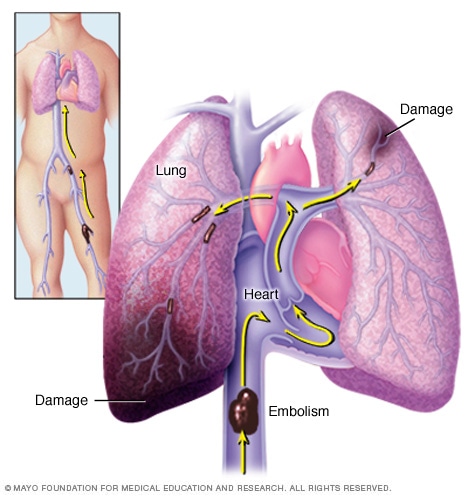Overview
Blood clot in leg vein

Blood clot in leg vein
A blood clot in a leg vein may cause pain, warmth and tenderness in the affected area.
Deep vein thrombosis (DVT) occurs when a blood clot (thrombus) forms in one or more of the deep veins in the body, usually in the legs. Deep vein thrombosis can cause leg pain or swelling. Sometimes there are no noticeable symptoms.
You can get DVT if you have certain medical conditions that affect how the blood clots. A blood clot in the legs can also develop if you don't move for a long time. For example, you might not move a lot when traveling a long distance or when you're on bed rest due to surgery, an illness or an accident.
Deep vein thrombosis can be serious because blood clots in the veins can break loose. The clots can then travel through the bloodstream and get stuck in the lungs, blocking blood flow (pulmonary embolism). When DVT and pulmonary embolism occur together, it's called venous thromboembolism (VTE).
Products & Services
Symptoms
Deep vein thrombosis (DVT) symptoms can include:
- Leg swelling
- Leg pain, cramping or soreness that often starts in the calf
- Change in skin color on the leg — such as red or purple, depending on the color of your skin
- A feeling of warmth on the affected leg
Deep vein thrombosis can occur without noticeable symptoms.
When to see a doctor
Pulmonary embolism

Pulmonary embolism
A pulmonary embolism (PE) occurs when a blood clot gets stuck in an artery in the lung, blocking blood flow to part of the lung. Blood clots most often start in the legs and travel up through the right side of the heart and into the lungs. This is called deep vein thrombosis (DVT).
If you develop symptoms of DVT, contact your health care provider.
If you develop symptoms of a pulmonary embolism (PE) — a life-threatening complication of deep vein thrombosis — seek emergency medical help.
The warning signs and symptoms of a pulmonary embolism include:
- Sudden shortness of breath
- Chest pain or discomfort that worsens when you take a deep breath or when you cough
- Feeling lightheaded or dizzy
- Fainting
- Rapid pulse
- Rapid breathing
- Coughing up blood
Causes
Anything that prevents the blood from flowing or properly clotting can cause a blood clot.
The main causes of deep vein thrombosis (DVT) are damage to a vein from surgery or inflammation and damage due to infection or injury.
Risk factors
Many things can increase the risk of developing deep vein thrombosis (DVT). The more risk factors you have, the greater your risk of DVT. Risk factors for DVT include:
- Age. Being older than 60 increases the risk of DVT. But DVT can occur at any age.
- Lack of movement. When the legs don't move for a long time, the calf muscles don't squeeze (contract). Muscle contractions help blood flow. Sitting for a long time, such as when driving or flying, increases the risk of DVT. So does long-term bed rest, which may result from a lengthy hospital stay or a medical condition such as paralysis.
- Injury or surgery. Injury to the veins or surgery can increase the risk of blood clots.
- Pregnancy. Pregnancy increases the pressure in the veins in the pelvis and legs. The risk of blood clots from pregnancy can continue for up to six weeks after a baby is born. People with an inherited clotting disorder are especially at risk.
- Birth control pills (oral contraceptives) or hormone replacement therapy. Both can increase the blood's ability to clot.
- Being overweight or obese. Being overweight increases the pressure in the veins in the pelvis and legs.
- Smoking. Smoking affects how blood flows and clots, which can increase the risk of DVT.
- Cancer. Some cancers increase substances in the blood that cause the blood to clot. Some types of cancer treatment also increase the risk of blood clots.
- Heart failure. Heart failure increases the risk of DVT and pulmonary embolism. Because the heart and lungs don't work well in people with heart failure, the symptoms caused by even a small pulmonary embolism are more noticeable.
- Inflammatory bowel disease. Crohn's disease or ulcerative colitis increase the risk of DVT.
- A personal or family history of DVT or PE. If you or someone in your family has had one or both of these conditions, you might be at greater risk of developing DVT.
- Genetics. Some people have DNA changes that cause the blood to clot more easily. One example is factor V Leiden. This inherited disorder changes one of the clotting factors in the blood. An inherited disorder on its own might not cause blood clots unless combined with other risk factors.
Sometimes, a blood clot in a vein can occur with no identifiable risk factor. This is called an unprovoked VTE.
Complications
Complications of DVT can include:
-
Pulmonary embolism (PE). PE is a potentially life-threatening complication associated with DVT. It occurs when a blood clot (thrombus) in a leg or other body area breaks free and gets stuck in a blood vessel in a lung.
Get immediate medical help if you have symptoms of PE. They include sudden shortness of breath, chest pain while breathing in or coughing, rapid breathing, rapid pulse, feeling faint or fainting, and coughing up blood.
- Postphlebitic syndrome. Damage to the veins from the blood clot reduces blood flow in the affected areas. Symptoms include leg pain, leg swelling, skin color changes and skin sores.
- Treatment complications. Blood thinners are often used to treat DVT. Bleeding (hemorrhage) is a worrisome side effect of blood thinners. It's important to have regular blood tests while taking blood-thinning drugs.
Prevention
Lifestyle changes may help prevent deep vein thrombosis. Try these strategies:
-
Move your legs. If you've had surgery or have been on bed rest, try to move as soon as possible. Don't cross your legs while sitting. Doing so can block blood flow.
When traveling, take frequent breaks to stretch your legs. When on a plane, stand or walk occasionally. If you're traveling by car, stop every hour or so and walk around. If you can't walk, do lower leg exercises. Raise and lower your heels while keeping your toes on the floor. Then raise your toes while keeping your heels on the floor.
- Don't smoke. Smoking increases the risk of DVT.
- Manage weight. Obesity is a risk factor for DVT. Regular exercise lowers the risk of blood clots. As a general goal, aim for at least 30 minutes of moderate physical activity every day. If you want to lose weight, maintain weight loss or meet specific fitness goals, you may need to exercise more.